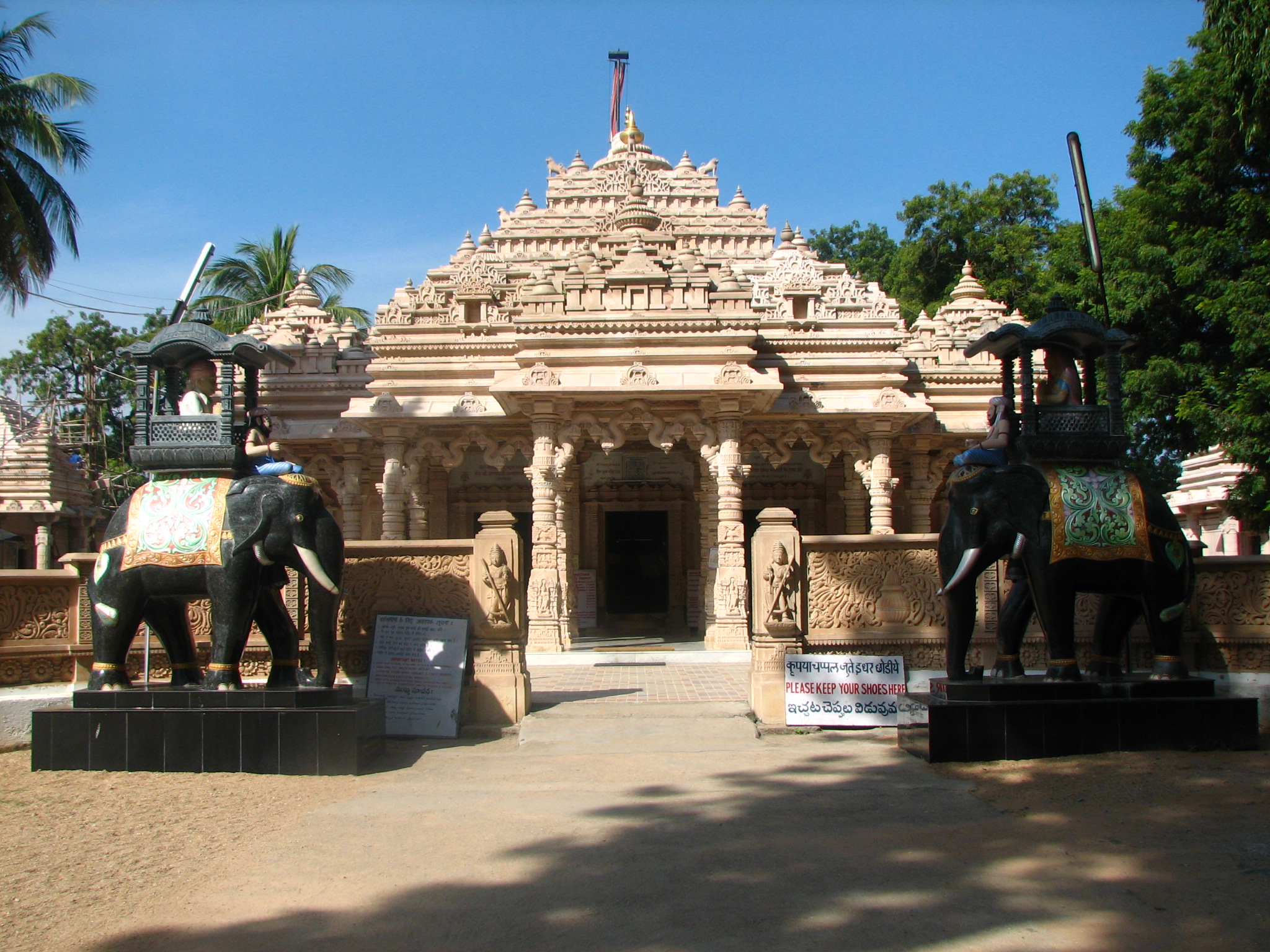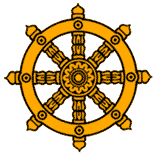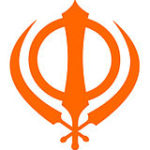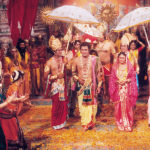
Among the most ancient traditions of Bharatavarsha is a religion that is referred to in the present time as Jainism. However, the philosophy given its present form by Mahaveera, is one better known by its native name, Jain Dharma.
The ‘Philosophy of Conquerors’ is famous for its emphasis on conquering the senses, and has become the living embodiment of absolute ahimsa. In documenting and disseminating the Diverse Dharmas of India, this present article marks the first in a new Series on Jina Dharma.
Introduction

The first Teerthankara is credited with propagating the value of asi, masi, and krishi. These were the fundamentals of dharmic life. It is a matter of poetic irony that the putative progenitor of this tradition of non-violence would stipulate the importance of the sword (asi). Nevertheless, this is in line with saamaanya dharma, and the need for self-defence. This in turn protects culture and arts (masi), and also safeguards agriculture (krishi). Collectively, these are the three pillars of Civilization as stipulated by the legendary founder of the faith. However, there were almost 2 dozen ‘ford crossers’ that followed him. The last two clearly took it in a different direction.
The Jain Teerthankaras
There were 24 total Jain Teerthankaras. The details of the lives of many of them are somewhat controversial and are often scarce. However the two best known are Parshva and Mahaveera. Nevertheless, the interweaving of Dharmic lineages is a frequent thread in the quilt of Indic Civilization. The Adinatha of the Jain Tradition is none other than a great Suryavanshi Kshatriya King.
Rishabha deva

Known to Jains as Adinatha, Rishabhadeva is a key figure to both the Vedic and Jina traditions. Though the Puranas don’t mention his practicing a fundamentally new spiritual path, Rishabadeva’s younger son Bahubali is ceremonialised in Sravanabelagola (Karnakata) by Jains to this day.
Regardless, he is seen as the first figure to open the path of spirituality to the lay people of Bharatavarsha. He was born to king Nabhi and queen Marudevi. He is considered the first Teerthankara, the first kevalin, and the first Chakravarthin.
Ajitanatha
Sambhavanatha
Abhinandananatha
Sumatinatha
Padmaprabha
Suparsvan
Chandraprabha
Pushpadantha
Sheetalanatha
Sheyansanatha
Shreyans Nath was born to Vishnu Raja and Vishnu Devi of Simhapuri. He was the eleventh Teerthankara. He is said to have become a sramana and in the short span of two months, attained moksha.
Vasupujya
Vimalanatha
Ananthanatha
Dharmanatha
Shanthinatha
Kunthunatha
Arhanatha
Mallinatha
Notable for being the only female Tirthankara, Mallinatha appears to run in opposition to the proverbial Jina view of only males being eligible for Moksha. She is said to have been born in Mithila in the Suryavanshi lineage to King Kumbharaja and Queen Prajavati.
Munishruv
Naminatha
Neminatha
Parshvanatha
The originator of the Nirgrantha sect, Parshva is said to have preceded Mahaveera by almost 250 years, and therefore, can be dated to approximately 850 BCE. He was born in Varanasi to King Ashvasena. Despite this, he roamed for 70 years as a mendicant, after having attained realisation through 83 days of intense penance. [2, 3] Parshvanatha is credited with the chaaturyaama samvara, or the fourfold path or restraint. He clarified the essentials of Jina Dharma as follows: 1.Ahimsa, 2. Aparigraha, 3. Asteya, 4. Sunrta. These translate to non-violence, non-possessiveness, non-stealing, and truth-telling.
Jain ganas were organised around this, each one headed by a ganaadhara (upholder of community). [3, 61]
Vardhamaana Mahaveera
Without a doubt, the most definitive Teerthankara was Vardhamana Mahavira. A kshatriya born, rather poetically, to another Siddhartha (chief of the Vaishali republic). His mother’s name was Trisala (daughter of the kshatriya Licchavi chief Chetaka). [5, 288] A member of the Jnaatrika clan, he began his life in a village called Kundagraama. Pandits such as Sri Kota Venkatachalam date him to 599 BCE. Mahaveera was also known as Veeranatha, due to his power and courage.
“Though he was brought up and educated in such environment as was prevalent in the aristocratic Ksatriya families of that time, from his early childhood he was unattached to the household life, and absorbed in quest of the highest spiritual knowledge.” [2, 5]
Though he was married to Yashoda (again rhyming with the life of another Siddhartha), he had a daughter named Priyadarsana (though Digambaras maintain he never married). He gave up the life of a householder at the age of 28, and began a life of austerity. A wandering mendicant, he aimlessly traveled from place to place, without changing clothes. Finally, even these decayed, and he became the clotheless monk he is known to be today.
After meditation and truth reflection, he attained moksha at age 42 at Jrmbhikagraama village, on the banks of the Rjukula river. [2, 6] He gave his first religious sermon at Rajagrha, capital of Magadha and was called Kevalin (the Perfect One) and Jina (Conqueror). [3, 60] He died at the nearby Bihari village of Paava. [5, 288] According to tradition, “he spent the first rainy season in Asthikagraama, the next three rainy seasons in Campa and Prsticampa, twelve in Vaisali and Vanjyagraama, fourteen in Raajagrha and Naalandaa, six in Mithuta, two in Bhadraka, one in Alabhika, one in Praneetabhoomi, on in Sravasti and the last one in Paavaa.” [2, 7]
The principal disciples of Mahaveera were Indrabhuti Gautama, Agnibhuti, Vayubhuti, Vyakta, Sudharmasvami, Manditaputra, Mauryaputra, Akampita, Achala-bhraataa, Metaarya, and Prabhasvaami. They were assigned the status of ganadharas by Mahaveera himself. Jambusvami was a key disciple of Sudharmasvami, and is regarded as the last omniscient (kevalajnani) among Jinas. [2, 8] Other prominent figures among Jainas are:
Bahubali, Dharmaghosha, Vidyaprabha, Lalitaprabhu, Vinayaprabha, and Mahimaprabhu. Bahubali is best known for the statue constructed in his honour at Chandragiri (Sravanabelagola) in Karnataka.
“Lord Mahaveera possessed a unique power of organization. By his wonderful personality and organizational skill, he attracted a large number of people, both men and women, to be his disciples.” [2, 7-8]
Jain Acharyas
The worldview of the Jinas is considered to be markedly distinct from that of Vedic Dharma. While the latter divides life into ashramas and encourages grhastashrama (householder life), Jina Dharma asserts the life of the monk as the only means to moksha.
“Their attitude towards life and the world was quite different from that of the Vedic priests…They did not accept God as Creator of the universe and dispenser of pleasures and pains. They believed that all potentialities are inherent in man. Man is latently divine and has the capacity to uplift himself to divinity and to rise to the highest stage of spiritual development. They did not have desire for long life, good food and drink, wealth, power, and heroic progeny which were the ideals of human life preached by the Vedic priests. Instead they believed in renunciation and abandonment of all worldly pleasures.” [2, 2]
Following the Teerthankaras, are numerous Jain Acharyas who all made their mark on this way of life:
Siddhasena
Samantabhadra
Hemachandra
Acharya Bhikshu
Acharya Umaswami
Composed the Tattvartha Sutra. This is considered the most important sutra in Jainism, and is considered the earliest compendium of Jain precepts. It was composed in the 2nd Century CE, around Pataliputra in Bihar.
Acharya Tulasi
He is the most prominent proponent of the Terapantha school of the Svetambara sect. They are not supporters of murthi puja and do not remain in sthaanakas (abodes) as the sthaanakavaasi school does. [2, 11]
Jain Sects
The first documented sect was Nirgrantha, meaning ‘Free from Bonds’. [5, 288] Though the Nirgrantha sect predates the two major ones, it has been eclipsed by them. As mentioned above, it was started by Parshvanatha, and established the foundational four vows of the tradition. To them, Mahaveera added 1 more (brahmacharya) to round out the pancha-mahavrata.
The common Jain world view can be summed up in the following words:
“Karma or action is the tie which binds the self to the body. Perverted knowledge, i.e. ignorance of truth (mithyaatva or avidyaa) causes the rise of passions (kasaayas) which are sticky substances where karmic particles stick. The passions which are anger (krodha), greed (lobha), pride (maana), and deceitfulness (maayaa) are the causes of the attraction of the inflow (aasrava) of karmic particles toward the self. When these particles enter into the soul and bind it, bondage (bandha) takes place.” [2, 6]
One can see many commonalities to Vaidikas here, particularly with regard to the passions. The equivalents in Sanatana Dharma would be the Arishadvargas (6 enemies). Rather than bondage, it is attachment and delusion (moha) that weighs down the jeevatma.
Mahaveera propagated the following as the solution:
“By the practice of right knowledge (samyag-jnaana), right faith (samyag-darshana) and right conduct (samyak chaarita), the stoppage (samvara) of the inflow of karmic particles is possible. And by the practice of austere penances (tapas) wearing out or exhaustion (nirjaraa) of the accumulated karmic particles is possible. After the last karmic particles being worn out and destroyed, the permanent bondage of the self with the body is loosened, and the self shines in its intrinsic nature of infinite knowledge (anantajnaana), infinite faith (anantadarshana), infinite bliss (anantasukha) and infinite power (anantaveerya), and become liberated (mukta)” [2, 6]
Mahaveera’s contributions led two the rise of two more sects.
Svetambara
Despite Mahaveera himself preferring to live nude, the Svetambara sect is characterised by the white clothes they wear, hence the name (white clad). Primarily found in Northwestern India (Rajasthan and Gujarat), it reformulated Mahaveera’s precepts codified in the Purvas. These became known later as Angas. Bhadrabahu was the 11th ganadhara in line from Parsva and preceptor to the Emperor Chandragupta.
When Bhadrabahu departed to the South, his disciple Sthulabhadra began leading the monks. They were accused of falling in to immoral practices. When he returned to the North, he contested the authenticity of these 11 Angas replacing the original Purvas, creating a schism. Bhadrabahu departed in disgust, leaving for Nepal. The northern Svetambara sect further divided into 3 schools: Murthipujaka, Sthanakavasi, and Therapanthi. The southern sect became known as Digambara. [3, 61]
Digambara
Digambaras take their name from their preferred method of living (sky-clad). However, only the male renunciates go about nude; female renunciates, much like their northern sisters, wear white clothes. [2 ] Some insist in fact that there should be no nuns, and do not recognise female renunciates. [3, 61] According to Tamil history, Jain Kings called Kalabhras invaded Tamil Nadu and spread Jina Dharma for a time, before eventually being pushed back. They are found primarily in Karnataka.
Digambaras are further divided as follows: Bisapantha, Therapantha, Taranapantha.
They believe Moksha is attained only by males. Females are reborn as males to attain it.
Communities
There are numerous communities of Jains throughout India. Despite regional concentrations, they speak many different languages. Primarily mercantile today, there were many prominent Rajputs who also adopted the faith. Some communities such as the Oswal Jains produced important political figures such as Bhamashah, the great minister of Maharana Pratap.
Principles of Jina Dharma

- ‘Parasparopagraho Jivanam’
- Ahimsa, Aparigraha, Asteya, Sunrta, Brahmacharya Jina Jeevita Panchavrata paalana
- Ratnatraya—Samyoga jnaana (Right knowledge), Samyoga Darshana (Right Faith), & Samyoga Charitra (Right Conduct)
- The four classes are not by birth but by conduct are Sramanas, Sramanis, Sravakas, & Sravikas.
- Asi, Masi, & Krishi
- Jaina is a non-Vedic Indian sampradaya. Mahaveera was not the founder of a new doctrine. He reformed, practiced, and preached the old Nirgrantha Dharma.
- Every jeeva is potentially a siddha & in siddhahood self-individuation is sustained
- The Eight karmas bind the self to the cycle of samsara.
- The acharas of the householder and that of the muni pave the way for realizing samvara, nirjara, and moksha.
- Samyag Darsana (spiritual awakening) gives the criteria for soul advancement.
- Munis perform guptis, samitis, sense control, 6 essentials & tapas as spiritual exercise.
- Right attitude facilitates the soul’s realisation of the truth.
- Ahimsa-anuvrata is also characterised by Non-Exploitation.
- There are 14 Gunasthaanas (stages of spiritual progress).
- Dhyana is made strong through shraddha, veerya, apramaada, vidya, & prajna.
- There are 4 types of Shukla-dhyaanas
- Yoga is the confluence of the Ratnatraya
- Preksha dhyaana, Jeeva Vijnaana & Anuvrata
- There are 5 great vows (panchavrata) for a monk, and a 6th vow which is ancillary.
- There are 6 essential duties (shadaavashyakas) for a male or female monk.
- As mother educates child, as physician cures the ill, so an arhat uplifts humanity.
- Study of the Anga Aagamas & Angabaahya Aagamas will lead to Truth realisation
- Saalekhana is not distressed suicide, but dispassionate unburdening of the earth.
- Jaina Ganas are led by Acharyas, Upadhyaayas, Pravartakas, Sthaviras, & Ratnikas.
Principles & Explanation of Jina Dharma
1. All life is mutually supportive
This phrase originates in the holy text Tattvartha Sutra. It is the central tenet of Jina Dharma and the motivation for its theory of ahimsa.
2. Non-violence, Non-possessiveness, Non-stealing, Truthfulness & Chastity
The four-fold principles of Parshvanatha were expanded to five-fold by Mahaveera. Though brahmacharya is associated with celibacy, for laypeople it is associated with Chastity.
“The Acaranga-sutra pronounces that one should neither deprive any living being of life, nor rule over him, nor torment hum nor ex[c]ite him.” [2, 49]
Attachment to possessions must be renounced. To take anything that is not given is considered stealing. To speak what is not commendable is falsehood.
3. Ratnatraya—Samyoga jnaana (Right knowledge), Samyoga Darshana (Right Faith), & Samyoga Charitra (Right Conduct)
Nirvana is attained through right knowledge, right faith, and right conduct. These form the Ratnatraya or 3 Jewels of Jina Dharma. This assertion comes from the Jain Tattvasutra and is common to the two major sects of Jainism. Right faith means belief in the 7 tattvas. Right knowledge means understanding of the 5 perceptions (senses, scripture, clairvoyance, telepathy, omniscience). Right conduct involves applications of knowledge through 5 kinds of spiritual purity (equanimity, penance for negligence of equanimity, refraining from injury, control of passions, contemplation of the soul).
4. The four classes are not by birth but by conduct and are Sramanas, Sramanis, Sravakas, and Sravikas.
Unlike Vedic Varnashrama Dharma, Jainas hold the four classes to be men and women of the ascetic class (sramana) as well as men and women of the lay class (sraavaka). Male monks may be with clothes (sachelaka) or without clothes (achelaka). However, female monks must be with clothes, as must men and women of the lay class.
5. Sword, Culture, Agriculture
These are the 3 principles of Karmic life established by Adinatha Rishabhadeva. They are essentials of preserving civilised life.
6. Jaina is a non-Vedic Indian sampradaya. Mahaveera was not the founder of a new doctrine. He reformed, practiced, and preached the old Nirgrantha Dharma.
Although the present paradigm attests that Mahaveera was the founder, orthodox practicioners of Jina Dharma hold that Vardhamana was merely the 24th in a line of Teerthankaras who expounded the Jina Dharma. Under his predecessor Parshvanatha, this was called Nirgrantha Dharma.
7. Every “jeeva is potentially a siddha & in siddhahood self-individuation is sustained.” [2, 47]
In contrast to Vedic Dharma which establishes the centrality of the paramatman to dependent jeevatmas, Jain dharma holds every jeevatman to be a potential siddha and ultimately a potential paramatman. The fundamental view of a supreme deity is not preferred, and the universe deemed a result of independent confluence of tattvas. However, arhats and siddhas are focal points for devotion of Jain adherents.
8. The Eight karmas bind the self to the cycle of samsara.
“Karmas are of varied nature, but the fundamental kinds of karma are eight in nature— i.jnaanavarneeya-karma: that which obscures knowledge, ii. darshanaavarneeya-karma: that which obscures undifferentiated cognition, iii. vedaneeya karma: that which produces the feeling of pleasure and pain, iv.mohaneeya-karma: that which obstructs right belief and right conduct, v. aayu-karma: that which determines the period of stay of self in a particular body, vi. naama-karma: that which is responsible for the built of a particular kind of body, vii. gotra-karma: that which determines status in society; and viii. antaraaya-karma: that which obstructs will power and enjoyable gains.” [2, 50]
9. The “acaras of the householder and that of the muni pave the way for realizing samvara, nirjara, and moksha”. [2, 51]
The path to release from bondage to karma begins through achara. This begins as householder and is ultimately completed in the final stage as muni. “Without moral observances, the spiritual practices cannot be sustained. According to the Jaina faith, moral and spiritual discipline find their completion in the life of the muni, since the life of the householder affords only partial ground for them.” [2, 55]
10. Samyag Darsana (spiritual awakening) gives the criteria for soul advancement.
One who has attained this has neither fear nor pride, he is not attached to pleasure, he is not worried about the hereafter, nor is he troubled by disease and misfortune. “Again he has comprehended the futility of pride, and consequently pride of learning, honour, family, caste power, opulence, penance” [2, 53] Even the body has been virtually forsaken by him. He does not obsess over the faults of others or the virtues he possesses. He practices the path of kindness.
“There may be a tendency to confuse spiritual awakening with moral and intellectual accomplishments…A spiritual unawakened man may be an astute intellectualist, a resolute moralist, but he will lack that spiritual quality by virtue of which he may be called a real saint, a seeker of spiritual truth, a person moving on the path or religion.” [2, 52-53]
11. Munis perform guptis, samitis, sense control, sixfold essentials, & tapas as spiritual exercise.
A muni must attain physical, mental, and spiritual control to be sustained in the atmanaic experience. He withdraws his mind, body, and speech from virtue and vice, auspicious and inauspicious, and all other dualities. This saadhana is called gupti. [2, 56] Eventually, he withdraws from the senses as well. Then he performs the 6 essentials, or six duties.
Lastly, he performs 6 types of tapas: i. anasana, fasting for a limited period of time, ii. avamaudaarya, less than minimum quantity of food, iii., vrttiparisamkhyaana, limitation on houses visited for food requests, iv. rasaparityaaga, abstinence from specific articles of food (such as sugar or salt), v. viviktasayyaasana, abandoning the dwellings of depraved housholders, and finally vi. kaayaklesa, enduring uncomfortable aasanas or postures.
12. Right attitude facilitates the soul’s realisation of the truth.
“The knowlege can be right only if the attitude is right. Similarly, rightness of conduct depends upon the rightness of knowledge.” [2, 83]
13. Ahimsa-anuvrata is also characterised by Non-Exploitation
Though predominantly practiced by mercantile communities today, the Jain tradition strictly prohibits economic exploitation. This is seen as an extension of non-stealing.
14. There are 14 Gunasthaanas (stages of spiritual progress)
The 14 Gunasthanas indicate the individual jeevatman‘s position on the path to spiritual perfection. They are marked by decreasing sinfulness and increasing purity, and are as follows [2, 91]:
- Mithya-drshti (perversity of attitude)
- Saasvaadana (faint tasting of right attitude)
- Samyag–mithyadrshti (right and wrong attitude)
- Avirata-samyagdrshti (right belief without abstinence)
- Desavirata (self control with spiritual inertia)
- Pramatta–samyata (self-control with spiritual inertia)
- Apramatta–samyata (self-control free from spiritual inertia)
- Apoorva–karana (shukla dhyaana and decline of gross passions)
- Anivrtti–karana (gross passions become powerless due to dhyaana
- Sookshma–samparaaya (immunity to all passions, save subtle greed)
- Upashaanta–kashaaya (suppressed passions, elimination of greed)
- Ksheena–kashaaya (absolutely annihilated passions)
- Sayoga–kevalin (Jeevanmukta)
- Ayoga–kevalin (Final Emancipation)
15. Dhyana is made strong through shraddha, veerya, apramaada, vidya, & prajna.
Dhyaana (meditation/concentration) is strengthend through necessary faculties. These are shraddha (faith), veerya (energy), apramaada (mindfulness), vidya (knowledge), prajna (insight). [2, 86] This ensures distinguishment (viveka) between inauspicious (aprashasta) and auspicious (prashasta) dhyaana. The first emerges from attachment (raaga) or hatred/aversion (dvesha), while the latter composes dharma-dhyaanas, dissociates from karmic matter, and facilites moksha.
16. There are 4 types of Shukla-dhyaanas
In the first, there is vitarka (thinking based knowledge). In the second there is absence of vichaara (aspect based analysis of objects). In the third, the verbal sense organ is completely subjugated, and in the fourth even subtle physical activities are subjugated. [2, 87]
17. Yoga is the confluence of the Ratnatraya
Per Acharya Haribhadra’s Yogashataka, the 3 ratnas of right knowledge, right faith, and right conduct come together in Yoga. Acharya Hemachandra asserts that yoga is in fact the final cause of spiritual emancipation. [2, 82]
18. Preksha dhyaana, Jeeva Vijnaana & Anuvrata achieve ahimsa.
Preksha jnaana invovles purification of emotions to ensure clear perception. Meditation should be done on the four virtues: friendship with all living beings, delight at seeing others advance, compassion for others, tolerance for the uncivil. Jeeva vijnaana involves the Science of Life applied through saadhana or spiritual regimen. Anuvrata involves the implementation of lesser or partial vows. These involve periodic fasting, limiting unnecessary movements, and so on.
19.There are 5 great vows (panchavrata) for a monk, and a 6th vow which is ancillary.
The 5 great vows of ahimsa, aparigraha, asteya, sunrta, and brahmacharya are well known. But there is a sixth vow against eating after dark. This applies mostly to monks out of consideration for insects and smaller organisms who are more active at night.
20. There are 6 essential duties (shadaavashyakas) for a male or female monk
i. saamaayika, equanimity amid pleasure and pain, ii. vandana, salutations to the Arhants and Siddhas, iii. stuti, contemplation and praise of the divine characteristics of the teerthankaras, iv. pratikramana, purification of faults through self-criticism, v. pratyakramana, retrospective reference, as well as pratyaakhyaana (prospective reference), and finally vi. Kaayotsarga, non-attachment to the body.
21. As mother educates child, as physician cures the ill, so an arhat uplifts humanity
22. Study of the Anga Aagamas and Angabaahya Aagamas will lead to Truth realisation
23. Saalekhana is not distressed suicide, but dispassionate unburdening of the earth.
Suicide is generally prohibited by Dharmic traditions. However, there are exceptions based on sampradaya. For example, jauhar-saka is permitted for practicioners of Vedic Dharma. For Jinas, saalekhana is permissible particularly for monks, who have attained all plausible knowledge in this lifetime. It may be permitted on rare occasion for adult laypersons who reflect on whether they have become a burden on society, and take the decision to voluntarily starve themselves to death.
24. Jaina Ganas are led by Acharyas, Upadhyaayas, Pravartakas, Sthaviras, & Ratnikas.
In descending order, there are 7 ranks of leadership in the Jain Organisation (Gana). Interestingly, if Bauddhas had Sanghas, Jainas had Ganas, and if the two words are put together we get Ganasangha (republic). That aside, the ranks are as follows:
- Acharya—Spiritual & administrative authority. Knowledgeable & high moral conduct.
- Upadhyaaya—Second to Acharya. Gives primary instruction to junior monks & nuns
- Pravartaka—Secondary administrator. Has sufficient moral & academic qualications
- Sthavira—3 levels based on age. Primarily instructs juniors in monastic discipline
- Ganin—Gives education to a specific group within the Gana
- Ganaavacchedaka—Head of a part of a Gana
- Raatnika—A senior monk. Seniority determined by scholarship & moral conduct
The Female Leadership is as follows
- Ganinee or Pravartinee—She is the leader of the order of Jain nuns. High morality
- Ganavachedinee—Head of a part of the female portion of the Gana
- Abhishekaa—Old experienced Nun
- Pratihaari—Senior nun, equivalent to a raatnika.
Jain Philosophy
 Jain philosophy has much in common with Buddhism and Hinduism. Fundamental ideas of Nirvana/Moksha, Dhyana, Yoga, and above all, Dharma, are common to all three. That is why, along with Sikh Dharma, these are considered the traditional Dharmic Faiths of India.
Jain philosophy has much in common with Buddhism and Hinduism. Fundamental ideas of Nirvana/Moksha, Dhyana, Yoga, and above all, Dharma, are common to all three. That is why, along with Sikh Dharma, these are considered the traditional Dharmic Faiths of India.
There are, however, some key distinctions. Jina Dharma is similar to Bauddha Dharma, in that neither of them positively assert an all-pervading Deity. If Vedanta asserts Oneness (aikya), and Buddhism claims nothingness (sunyata), Jains hold to plurality (anekanta). This has resulted in the view of not only a multiplicity of souls, but also a many-sidedness of views/policies (nayas). According to Jainism, each jeevatma has the potential to perfect itself and become paramatma (distinguishing the usage of this term in Hinduism). Perfect souls are arhats (who are embodied) and siddhas (disembodied).
Per Jain Cosmology, the universe is Eternal and consists of a multiplicity of souls. There are numerous time cycles consisting of periods of ascent (utsarpini) and descent (avasarpini), which are each 40,000 years in length. Each period contains 24 Teerthankaras, 12 Chakravarthins, and 63 Saalaaka-purusas (great men). [5, 290] There are a number of undercurrents in Jain Philosophy. These are rather detailed and nuanced, and best discussed separately. For now, here is a useful restatement:
Jain philosophy is premised on the sapta-tattvas (7 principles). These are jeeva, ajeeva, aasrava, bandha, samvara, nirjara, and moksha. [2, 13]
The universe is manifested through the interaction of jivas (lives). There are 5 categories of ajiva (non-living), which are akasa (ether), dharma (movement), adharma (non-movement), kaala (time), and pudgala (matter). Souls (atman) are contained not only in living things, but non-living as well (such as water and earth). Karma is a result of activity, attaching punya or paapa to an atman. Annihilation (nirjara) of karma is brought about through tapas (austerity). This causes prevention (samvara) of influx (asrava) and bondage (bandha). Raagas (attachment) to sensual pleasures lead to downfall of the atman. Though Nirvana is available to all atmans, but not all seek to become paramatman (the perfected soul). As a result they go to heaven for merits and hell for demerits, and continue the cycle of samsaara afterward. Unlike Bauddha Dharma, parinirvana (per digambaras) is available only to monks and males, with females having to be reborn as males. Buddhists also prescribe the middle path rather than extreme austerity in order to break the cycle of samsaara. [5, 290]
“The Jainas categorically deny the possibility of the apprehension of the reality through the senses and the mind, because it is the senses that have made the aatman look outward away from the centre of reality. Only direct intuition leads the soul to the very inwardness of reality, and thus through this extra-sensory perception it gains back the directness of apprehension it had lost.” [2, 96] There are 3 types of direct knowledge, avadhi (clairvoyance), manahparyaya (telepathy), and kevala (omniscience).
Though Jinas are generally nirishvarvaadins, they do practice devotion to arhats and siddhas. While these beings are not affected by prayer and song, meditating on them purifies the mind and spiritually advances a jeeva.
These aims, commands, and philosophical concepts are codified in various texts. The most important of these are the 14 Purvas (or the 12 Angas)
Canonical Jain Texts
“It appears that the original Pitakas or Aagamas contained only the twelve texts called Dvaadasaanga, literally, ‘twelve limbs’ of the body of the doctrine (siddhanta) of the jinas. Both the schools maintain that the ganadharas were the authors of the twelve texts…These Aagamas are divided into two classes: Anga Aagamas or the original twelve books and Angabaahya Aagamas or the texts outside the twelve books“. [2, 99] These are more colloquially known as Canonical and Non-Canonically Jain Texts.
Due to the great schism between the Svetambara and Digambara sects, there is a slight epistemological disjunction. The original Jain Texts were referred to as the 14 Purvas. These later developed into the 12 Angas. The Canonical Jain texts as a whole are referred to as Agamas.
The 12 Angas
This is the Jain Canon of the Svetambara sect. However, the 12th limb has been lost, reducing the total to 11. These 11 limbs contain a corpus of 45 texts in Ardha-Magadhi Prakrit prose and poetry. They are thought to have reached their final form when the Third Council met in 454 CE, at Vallabhi (Gujarat). The corpus is divided as follows
- 12 Upaanga (secondary limbs)
- 10 Pakirnaka (miscellaneous texts)
- 6 Chhedasutra (separate texts)
- 4 Mulasutra (basic texts)
- 2 Nandi sutra (blessings)
- Anuyoga (door of inquiry)
The first Anga is Acharangasutra. As indicated by the name, it stipulates the rules of conduct (Achara) for a Jain monk.
The second Anga is Sutrakrtanga, and is a dialectical text dedicated to refuting heretical Jina doctrines. The third and four angas are Sthaananga and Samvayamga respectively. The present Jina doctrines and essential beliefs. [4, 443]
Bhagavati is the fifth Anga. It is considered the most important one. This is because the biographies of Mahaveera and numerous other Teerthankaras are provided. Notably, it includes an account of the life of founder of the Ajivikas (Gosaala Maskariputra).
The sixth Anga is Jnaatadharmakathah. Through the use of parables and legends, it instructs adherents on the principles of Jina dharma. The seventh Angra provides a katha on the conversion of 10 wealthy merchants to Jaina. The eight and ninth Angas are Antakriddasah and Anuttraupapaatikadasaah respectively. They furnish additional legends on the lives of Jain ascetics, and how they ultimately managed to avoid hell and attain heaven. Prasnavyaakaranaani is more dogmatic in nature. It explicates the 10 precepts and 10 prohibitions. [4, 443]
The eleventh Anga is Vipaakasrutam, and is an expository on karma. The 12th Anga is Drstivaada and has been lost. Nevertheless, these 11 Angas are divided into various categories as stipulated above (forming the corpus of Canonical Jain Texts). However, the single most important component of the Angas is the Jain Kalpasutra.
Jain Kalpasutra
The Jain Kalpasutra is actually sub-section of the fourth Chhedsutra. The Kalpasutra itself is sub-divided into 3 sections, and is attributed to Bhadrabahu. The first section is Jina-Charita, and as evidenced by the name, details the lives of the various Jina Teerthankaras. The second part is called Theravali, and it provides a list of the different Jain schools. Finally, true to the name Kalpasutra, part 3 details rules and rites observed by monks. It is said that an ancillary Kalpasutra is the basis for the 5th chhedasutra, and contains much of the same. [4, 444]
Non-Canonical Jain Texts
Languages of the Jain texts run the gamut of the subcontinent. They include Ardhamagadhi Prakrit, Sauraseni Prakrit, Sanskrit, Tamil, Kannada, Gujarati, and Hindi.
Niryuktis are highly efficacious commentaries on the various Canonical Texts of Jina Dharma. Traced to the time of Bhadrabahu, they soon evolved into Prakrit Bhashyas and Churnis as well as Sanskrit Teekas and Vrttis.
Haribhadra is considered one of the most famous of these bhashyakaaras. He was a scholar and poet in the ninth century CE, and has 1444 works attributed to him. Other commentators include Shantisuri, Devendragni, and Abhayadeva, who all date around the 11th Century CE.
There are numerous other stories that are associated with the tradition, that are not considered canonical.
- Kaalakaachaarya-kathaanaka
- Uttama-charitra-kathaanaka
- Champaka-sresthikathaanaka and Paala-Gopaala-kathaanaka by Jinakeertisuri
- Samyaktvakaumudi
- Kathakosa
- Antarakatha-samgraha by Rajasekhara
- Kathamahodadhi by Somachandra
- Katharatnaakara by Hemavijaya
- Kathakosa and Panchasati-prabodhasambandha by Subhaseelagni
There are, naturally, numerous charitras and prabandhas associated with the Jain tradition as well. Nevertheless, the Jain contribution to Indic Literature is better dealt with elsewhere. In any event, it can be summed up as follows.
“The contribution of the Jainas in the field of literature and art are also manifold. They wrote excellent poetry, folk naratives, Puranas, lexicons, grammar and prosody, astronomy and mathematics, besides their master-pieces on logic and metaphysics. Their sacred literature, known as Agamic literature is a vast treasure-house of the social and cultural life of ancient times.” [2, 1]
Dietary Restrictions
- Vegetarianism
- Avoid root vegetables such as onions and potatoes
- Drink strained water whenever possible
- Do no eat between sun-rise and sunset
Jain Pilgrimage Sites

- Palitana
- Dilwara
- Chandragiri (Sravanabelagola)
- Osian
- Vaishali
- Ranakpur
Conclusion

Click here to buy this book!!!
The widespread influence and imprint of Jina Dharma cannot be minimised. From Vaishali in North Bihar to Kanyakumari in Tamil Nadu, symbols of its ancient and modern contributions can be found throughout the Indian Subcontinent. Despite the ebb-and-flow of sampradayic rivalries, claims, and counter-claims, there is an essential unity found in the saamaanya dharma of all spiritually sincere dharma sampradayas.
These seek to uplift mankind from the miseries of sense-enslavement to the balanced life of self-control and ultimately to the perfection of self-mastery. Each one emphasises this in different ways, but the basic message remains the same. Jina Dharma approaches this through emphasis on ahimsa. 
Though the concept can be found in the Bhagavad Gita, it reached its absolute implementation in the path of the Jains. As a result, “A man may be moral without being religious.” [2, 41] What other faith could be so considerate as to not only sweep the path to avoid stepping on insects or to cover ones mouth to avoid inhaling them? Going beyond vegetarianism, even honey, root vegetables, and water unfiltered of organisms are frowned upon. It is willing to go even to the difficult and impracticable extreme of questioning the ethics of clothing, even discarding them if found wanting—as in the case of silk and polyester. The first true motivation for sense control is to avoid causing harm. Jaina, so to speak, is peak ahimsa.
And yet, this wonderful way-of-life is filled with its own nuances. While renunciate Mahaveera made the maximal impact, it is the Ikshvaku Emperor Rishabhadeva who is claimed as the Jina Adinatha. He himself advocated asi (the sword) as part-and-parcel of earthly karma. The Odia Emperor Kharavela was at once a conqueror and a Jain, as were numerous Rajput rulers. Warlike Jain kings could be found from Magadha to Rajasthan to the Kalabhras of Karnataka. In the Dakshinapatha, Chalukyas, Rashtrakutas, and Kadambas were all patrons of Jainism. Even the once-upon-a-time Hoysalas of Halebidu and Kakatiyas of Warangal were Jains before becoming staunch Vaishnavites and Saivites respectively. [4, 430] How to reconcile all these quandaries of history?

—Dharma.
It is Dharma that forms the basic binding agent from the length and breadth of Bharatavarsha. Darsanas and drstis may change, but the central significance of this concept must not be eliminated. If it is the righteous upholding of Rta, which is the expression of Satya in the Veda, then Dharma is at once matter and cosmic order in Jaina. It is this desire to live in harmony with the universe and all living things that makes this “religion of conquerors” the most humanistic through its embrace of all possible methods of non-violence.
Jina Dharma is the ancient embodiment of the phrase, ‘Ahimsa paramo dharma’.




References:
- Acharya Mahaprajna. “The Jain Contemplative Tradition”. The Contemplative Life. Mayavati, Uttarakhand: Adhyaksha Advaita Ashrama. 2018
- Talib, Gurcharan. Jainism. Punjab University.
- SarDesai, D.R. India: The Definitive History. Philadelphia: Westview Press. 2005
- Majumdar, R.C. Ancient India. Delhi: MLBD. 2003
- Basham, A.L. The Wonder that was India. Delhi: Rupa. 2010
- https://www.speakingtree.in/blog/jain-dharma-and-food-habit
- https://www.speakingtree.in/blog/names-and-symbols-of-24-tirthankaras












